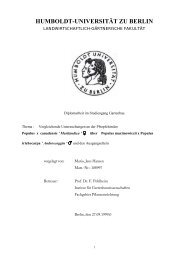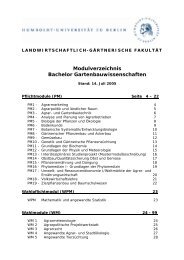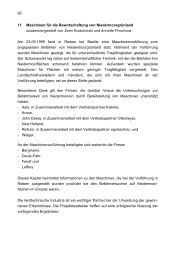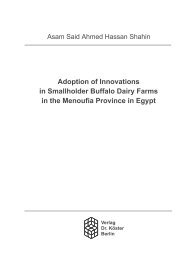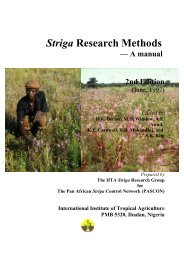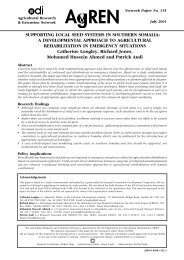Rice-Wheat Cropping Systems of the Indo-Gangetic Plain of India
Rice-Wheat Cropping Systems of the Indo-Gangetic Plain of India
Rice-Wheat Cropping Systems of the Indo-Gangetic Plain of India
You also want an ePaper? Increase the reach of your titles
YUMPU automatically turns print PDFs into web optimized ePapers that Google loves.
ACZ A5—Western Zone: This zone<br />
constitutes <strong>the</strong> south-western arid parts <strong>of</strong><br />
Haryana state interspersed with desert-like<br />
soils, sand dunes, scarce water availability,<br />
highly brackish (poor quality) waters and<br />
limited canal irrigation resource. Thus, rice<br />
area in this zone is nominal as rice growing<br />
is limited to certain pockets only, where,<br />
besides canal water, some supplemental<br />
tubewell irrigation water is also available<br />
(Fig. 3).<br />
Agroclimatic Region V: Upper<br />
<strong>Gangetic</strong> <strong>Plain</strong> Region (Uttar<br />
Pradesh)<br />
ACZ B1—Western <strong>Plain</strong> Zone: This zone<br />
constitutes <strong>the</strong> western-most districts <strong>of</strong><br />
Uttar Pradesh, forming <strong>the</strong> Yamuna-Ganga<br />
Doab, <strong>the</strong> most fertile zone <strong>of</strong> <strong>the</strong> state. It<br />
comprises <strong>the</strong> districts <strong>of</strong> Saharanpur,<br />
Muzaffarnagar, Meerut, Ghaziabad and<br />
Bulundshahr. It constitutes <strong>the</strong> sugarcane<br />
belt <strong>of</strong> Uttar Pradesh. Agroclimatically, it<br />
is well endowed with a congenial climate,<br />
almost resembling <strong>the</strong> Central <strong>Plain</strong> Zone<br />
(Punjab) and Eastern Zone (Haryana). It<br />
possesses an extensive network <strong>of</strong> irrigation<br />
and abundant underground water reserve<br />
(due to high recharge from <strong>the</strong> Yamuna and<br />
Ganges Rivers and <strong>the</strong>ir tributaries coming<br />
from <strong>the</strong> Himalayas). In spite <strong>of</strong> all <strong>the</strong>se<br />
favorable factors, it has, however, very<br />
minimal area <strong>of</strong> rice and that too confined<br />
mostly to district Saharanpur (Fig. 3). This<br />
area has a large number <strong>of</strong> sugar factories,<br />
both in <strong>the</strong> organized and unorganized<br />
(farmer-owned unrefined sugar<br />
manufacturing units) sectors. Fur<strong>the</strong>r, as<br />
sugarcane is <strong>the</strong> most popular crop, <strong>the</strong>re is<br />
little scope for rice which competes with<br />
sugarcane for labor, capital and intensive<br />
field care.<br />
ACZ B2—Mid-Western <strong>Plain</strong> Zone and<br />
‘Bhabar and Tarai Zone’: This modified<br />
zone, primarily constituting <strong>the</strong> districts <strong>of</strong><br />
Mid-Western <strong>Plain</strong>s <strong>of</strong> Uttar Pradesh, has<br />
been enlarged to include <strong>the</strong> Bhabar and<br />
Tarai belts, which constitute two narrow<br />
strips lying one above <strong>the</strong> o<strong>the</strong>r on <strong>the</strong><br />
North <strong>Plain</strong>s districts comprising <strong>the</strong> Mid-<br />
Western Zone. This zone comprises <strong>the</strong><br />
productive Rohil Khand area covering <strong>the</strong><br />
districts <strong>of</strong> Bijnor, Moradabad, Rampur,<br />
Pilibhit, Budaun, Bareilly, Nainital<br />
(including Udhamsingh Nagar) and<br />
Lakhimpur (Kheri) parts <strong>of</strong> Tarai. This area<br />
constitutes <strong>the</strong> sub-humid zone. It has an<br />
annual rainfall <strong>of</strong> 1000–1200 mm and also<br />
enjoys ample irrigation resources. The<br />
underground water-table is shallow and can<br />
be easily exploited. Soils too are<br />
comparatively heavy permitting successful<br />
cultivation <strong>of</strong> rice. <strong>Rice</strong> constitutes a major<br />
crop <strong>of</strong> <strong>the</strong> area, only next to wheat, and<br />
accounts for <strong>the</strong> highest rice area<br />
concentration in ACR V (Fig. 3).<br />
ACZ B3—Central <strong>Plain</strong> Zone: This zone<br />
comprises <strong>the</strong> districts lying between<br />
Allahabad in <strong>the</strong> East to Kanpur in <strong>the</strong><br />
West and includes <strong>the</strong> districts <strong>of</strong><br />
Lakhimpur (Kheri), Sitapur, Hardoi,<br />
Farrukhabad, Etawah, Kanpur, Kanpur<br />
Dehat, Unnao, Rae Bareli, Fatehpur and<br />
Allahabad. It constitutes <strong>the</strong> Awadh area<br />
<strong>of</strong> Uttar Pradesh. It has an annual rainfall<br />
<strong>of</strong> 800–1200 mm and is liberally sourced by<br />
<strong>the</strong> Ganges and Yamuna Rivers and <strong>the</strong>ir<br />
tributaries. Soils are deep alluvial, medium<br />
to medium heavy textured but are easily<br />
ploughable. The favorable climate and soil,<br />
and <strong>the</strong> availability <strong>of</strong> ample irrigation<br />
facilities make growing <strong>of</strong> rice a natural<br />
choice for <strong>the</strong> area. This zone has a<br />
sizeable area <strong>of</strong> rice though its scatter is<br />
generally more widespread (Fig. 3).<br />
ACZ B4—South-Western Semi-Arid Zone:<br />
ACZ B4—South-Western Semi-Arid Zone:<br />
This zone lies in <strong>the</strong> south-west Uttar<br />
Pradesh, just below Zones B1 and B2 on<br />
<strong>the</strong> border <strong>of</strong> Rajasthan, and constitutes<br />
relatively <strong>the</strong> driest parts <strong>of</strong> Uttar Pradesh.<br />
The area has mostly a rainfed farming type<br />
<strong>of</strong> environment and, <strong>the</strong>refore, accounts for<br />
9



